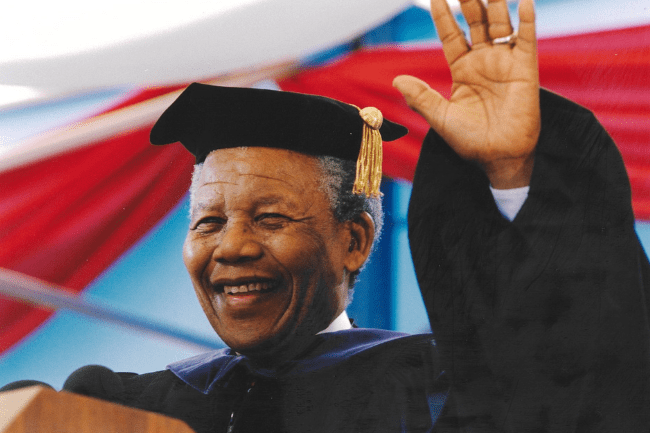Photo Above: Nelson Mandela Speaks on the Yard, 1994
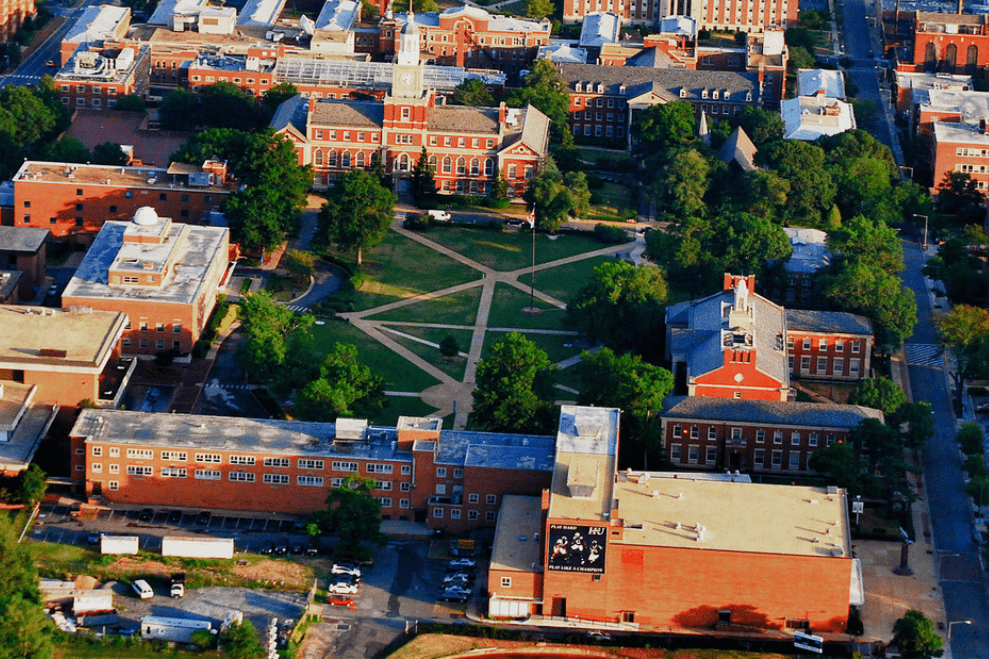
Vice President Kamala Harris has been clear that Howard University holds special meaning for her. Indeed, it has been a special place for the majority of American history, and there is no place on campus more important than “the Yard” which will host the Harris/Walz election night event.
The Yard
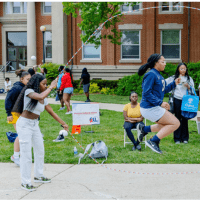
First of all, its important to note that its name is “the Yard” and not “the Quad” as has been erroneously reported. There is nothing novel about a quadrangle on a college campus, most often bordered by a library at one end. The Yard at Howard, has a different feel.
Howard is where thought and culture leaders gather to research, learn, and collaborate. Seminal conversations between the world’s most influential people have occurred on campus, and students have studied here who go on to literally change the world. Life-changing research happens on campus every day. It is a place of reverence and historic significance, to be sure. But above all, it is home.
The heart and soul of Howard are its people, including the fifteen thousand students, faculty, and employees who study and work there. Every traditional home has a front yard and a backyard where people gather to engage with each other, have serious conversations, or just relax. And just as that home has its “yard,” so too does Howard.
Nelson Mandela speaks at Howard University following his release from prison in 1994.
Notable Speakers and Luminaries
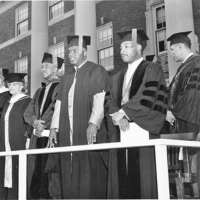
The Yard has been the venue for scores of Howard University Commencements and other ceremonies, serving as the backdrop for speeches from multiple U.S. presidents and other luminaries. U.S. presidents who have spoken on the Yard include Calvin Coolidge in 1924, Herbert Hoover in 1932, Harry Truman in 1952, Lyndon Johnson in 1965, and Barack Obama in 2016. George H. W. Bush spoke there as vice president in 1981. Bill Clinton delivered a Commencement address there during his post-presidency in 2013. In 1957, the legendary Jackie Robinson and Dr. Martin Luther King Jr., received honorary degrees on the Yard. Nobel laureate Nelson Mandela also spoke on the Yard in 1994, shortly after his release from prison. General Colin H. Powell spoke there in 1994, and Oprah Winfrey’s 2007 speech there was named one of the “Best Commencement Speeches, Ever,” by NPR.
Oprah Winfrey (D.H. '07) speaks at Howard's 2007 Commencement on The Yard.
Yardfest
Each year, thousands of Howard alumni and their families return to the Yard to celebrate homecoming. Homecoming traditions include legendary “Yardfest” concerts, which have been featured in major publications like the Washington Post, Vibe Magazine, and the New York Times. In 2022, the Smithsonian’s National Museum of African American History and Culture recently launched a digital experience chronicling the HBCU homecoming phenomenon, prominently featuring Howard's celebration. Yardfest performers include Grammy winners Jay-Z, Drake, Nipsey Hussle, Ludacris, T-Pain, Kanye West, Faith Evans, and CeeLo Green, along with the Notorious B.I.G., Lil Uzi Vert, Jeezy, and Grammy, Oscar, and Golden Globe winner Common.
Drake performs at Howard Yardfest, 2012
Greek Letter Fraternity and Sorority Trees
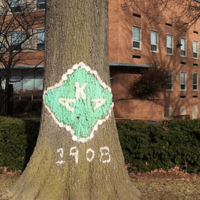
The Yard is also the heart of Greek life at Howard University, where many of the trees are painted with Greek letters in tribute to trailblazing Black fraternities and sororities. Five of the nine most prominent Black sororities and fraternities, called the Divine Nine, were founded at Howard. These include Alpha Kappa Alpha Sorority, established in 1908, which is the oldest Black sorority and of which Vice President Kamala Harris is a member. Other fraternities and sororities founded at Howard include Omega Psi Phi Fraternity (1911), Delta Sigma Theta Sorority (1913), Phi Beta Sigma Fraternity (1914), and Zeta Phi Beta Sorority (1920). Today, these five organizations collectively have more than 1.2 million members in some 4,200 chapters all over the world who engage in civic service, social justice advocacy, community leadership, and support for education.
Founders Library
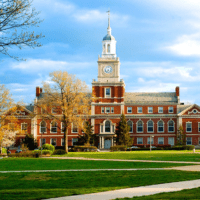
The Yard is dominated in the south by Founders Library. The building, which houses the university’s main library, is based on the design of Independence Hall in Philadelphia, where both the Declaration of Independence and the U.S. Constitution were adopted and features a clock tower that rises to 185 feet above the nation’s capital. The home of Howard Law School from 1944-1955, Founders provided the space where Thurgood Marshall and law school dean Charles Hamilton Houston drafted the legal strategy which led to their victory in the Brown vs. Board of Education Supreme Court case which precipitated the outlawing of segregation. The initial funding for Founders was provided by a $1 million congressional appropriation in 1929, and Secretary of the Interior Harold Ickes helped dedicate it as it opened a decade later. When it opened, it was the most expensive building on any college campus in America. Founders houses first editions of works by pivotal Black authors including Zora Neal Hurston and contains the papers of Paul Robeson and Alan Locke.
Immediately after Vice President Kamala Harris took her oath of office, the bell in the Founders clock tower rang 49 times to recognize the Howard alumna’s ascension to become the 49th vice president of the United States of America.
Andrew Rankin Memorial Chapel
Adjacent to the library, Andrew Rankin Memorial Chapel has been graced by some of the most distinguished orators in the world, such as Frederick Douglass, Mary McLeod Bethune, W. E. B. DuBois and Benjamin E. Mays, along with American and foreign leaders including John F. Kennedy, Eleanor Roosevelt, Haile Selassie I, and Desmond Tutu. It has also featured some of the most acclaimed American preachers in history, such as Vernon Johns, Dr. Martin Luther King, Jr., Reinhold Niebuhr, and Howard Thurman.
Childers Hall
The Yard is anchored on the north side by Lulu Vere Childers Hall, named after the founder of the university’s School of Music and its musical director for 37 years. Erected in 1961, the building houses the Chadwick Boseman College of Fine Arts named for the famed late alumnus who starred as Black Panther of the same-titled Marvel blockbuster, and portrayed icons such as Jackie Robinson in 42, James Brown in Get on Up, and Thurgood Marshall in Marshall. The Academy Award plaque for Hattie MacDaniel, the first Black person to win the Oscar, is housed in Childers Hall.
The building houses a performing arts theater, band and choir rehearsal facilities, a dance studio, a recital hall, and an art gallery. Fine arts majors at Howard who would have studied and performed in Childers include Golden Globe winner Taraji P. Henson (B.F.A, ’95), Emmy nominee Anthony Anderson (B.F.A. ’22), Grammy winner Jessye Norman (B.M. ’67), The Steve Harvey Show and The Game’s Wendy Raquel Robinson (B.F.A. ’89), Grey’s Anatomy star Isaiah Washington, Power’s La La Anthony, All Rise’s Simone Missick (B.A. ’03), A Black Lady Sketch Show’s Gabrielle Dennis, Lean on Me, The Cosby Show, and A Different World’s Karen Malina White (B.F.A. ’86), Grammy nominee Kenny Lattimore, Martin’s Carl Anthony Payne, Marlon Wayans, House of Payne’s Lance Gross (B.A. ’04), Grammy winner Donnie Hathaway, Emmy winner Lynne Whitfield (B.F.A., ’75), Golden Globe and Emmy-winning Kennedy Center Honoree Debbie Allen (B.F.A. ’72), and her big sister, Tony Award winner Phylicia Rashad (B.F.A. ’70), who served as dean of the Boseman College of Fine Arts.
Frederick Douglass Memorial Hall
Buttressing the Yard on the west side is Frederick Douglass Memorial Hall, built in 1935 and honoring the legacy of the 19th-century abolitionist and intellectual. Designed by Albert Cassell, a prominent African American architect, the building houses the departments of political science, sociology, and history, continuing Howard's mission of education and advocacy. Douglass was a member of the Board of Trustees at Howard from 1871-1895.
Dr. Ralph Bunche (M.A. ’28), the first Black person to obtain a doctorate in political science in America, founded Howard’s political science department.
OTHER BUILDINGS ON THE YARD
Alain Locke Hall
On the Yard’s southeast corner sits Locke Hall, the home of the College of Arts and Sciences, the oldest and largest of the university’s academic divisions, and honors programs. The building is named for Alain LeRoy Locke, the first African American Rhodes Scholar who taught at Howard for 41 years and served as the head of the Department of Philosophy.
Carnegie Library
The southwest side of the Yard is bordered by Carnegie Library, built in 1820. Donated by billionaire steel magnate Andrew Carnegie, Carnegie Library was the campus’s original library until the building of Founders Library. Today, it houses the Office of Undergraduate Studies.
Blackburn Center
The northeast corner of the Yard provides access to the Armour J. Blackburn University Center, the social hub of campus. The center houses the university’s principal ballroom, the Punchout eatery, a Chik Fil A, a cafeteria, a concessions store, and offices for student services and student government. Built in the 1970s, the center was named in honor of Armour J. Blackburn, an influential Howard alumnus as Dean of Students and founded founded the first University Center. The Blackburn Center offers dining, meeting spaces, and event halls, making it a popular venue for both student activities and historic events.
A Bridge Across and Beyond Statue
"A Bridge Across and Beyond," created by American artist Richard Hunt, is an abstract bronze sculpture located at Howard University's Blackburn Center. The piece features two large, pyramid-like forms that lean towards each other over a reflecting pool, symbolizing a bridge between Africa and African American descendants. Abstract African symbols connect the two forms, representing unity and heritage.
The sculpture was donated by John Debrew, Jr., CEO of the Mildred Andrews Fund, as a tribute to his mother, Katie May Artis Debrew, and single mothers everywhere.
Symbiosis Statue
"Symbiosis," an abstract sculpture by American artist Richard Hunt, is located at Howard University's Carnegie Hall. Made of corten steel, the piece resembles a head—human or animal—with appendage-like features and rests directly on the ground. Sometimes referred to as "Bison," it was gifted to the university by Hobart Taylor, Jr., a former member of the Board of Trustees, and dedicated in December 1981 after Taylor's death.
Keep Reading
-
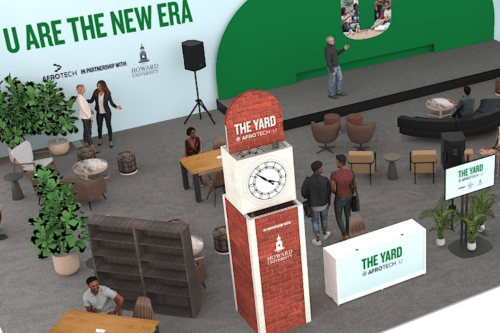
HOWARD UNIVERSITY LAUNCHES “THE YARD AT AFROTECH U,” November 14-15, 2024
Nov 14, 2024 4 minutes -
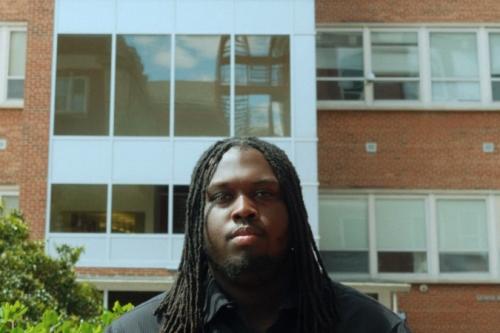
Howard Prioleau Makes History as First HBCU Student Selected in Google’s Ph.D. Fellowship
Nov 14, 2024 4 minutes
Find More Stories Like This
Are You a Member of the Media?
Our public relations team can connect you with faculty experts and answer questions about Howard University news and events.
Submit a Media Inquiry

